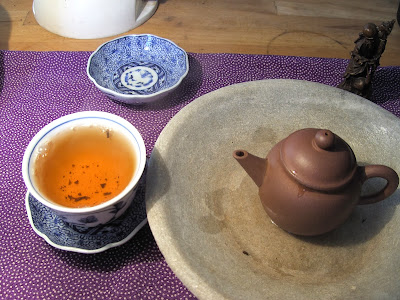Heute hatte ich fast so etwas wie eine Verkostung. Nicht ganz, denn ich schleppe eine beharrliche Erkältung mit mir rum, die mich husten und schniefen lässt. So sind meine Möglichkeiten zu schmecken und zu riechen sehr eingeschränkt. Trotzdem hatte ich Lust, einen neuen Tee zu erleben - auch wenn ich mich mehr auf andere Eindrücke als Geschmack oder Duft verlassen musste.
The tea I picked is a very young one: ManZhuan 2013. Manzhuan is one of the traditional Six Famous Tea Mountains, it is situated between Yiwu and Gedeng in eastern Xishuangbanna. A good collection of Yunnans tea mountains can be found here on Teachat.com.
Der Tee der Wahl is ein sehr junger: ManZhuan 2013. Manzhuan ist einer der traditionellen Sechs Berühmten Teeberge und liegt zwischen Yiwu und Gedeng im östlichen Xishuangbanne. Eine gute Sammlung von Karten der Teeberge Yunnans findet man hier auf Teachat.com.
The cold has not affected my eyes, so I could fully enjoy the beautiful, healthy looking leaves. A good silvery shine to the dark green leaves and an aroma (well, okay, I couldn't keep my rather congested nose from sniffing) which reminded me of an unusual Longjing green tea.
Die Erkältung hat nicht meine Augen getrübt, also konnte ich die schönen, gesund aussehenden Blätter bewundern. Ein silbriger Schimmer auf den Blättern und ein Duft (ja okay, dann konnte ich eben doch nicht meine verstopfte Nase von den Blättern fern halten) der mich an ungewöhnlichen Longjing Grüntee erinnert.
Thinking of Longjing (and following the line of thought that very young sheng is similar to green tea) I chose to brew this Manzhuan like a green tea: using fewer leaves, water which had cooled down a little and extended infusion times.
An Logjing erinnert (und der Ansicht folgend, dass ganz junge Sheng wie Grüntees sind), entschied ich mich für eine Zubereitungweise wie bei einem Grüntee: weniger Teeblätter, Wasser unter dem Siedepunkt und längere Ziehzeiten.
The first infusion really turned out somewhat flowery like a green tea - as far as my limited impression of taste went. But there was so much more: a tingling feeling in my mouth, lingering long after the tea was swollowed. And an increased awareness of the blood pulsing through my body. Over the next infusions something else happened: my nose opened up - an effect caused by gushu leaves.
Der erste Aufguss erschien dann wirklich etwas blumig wie ein Grüntee - soweit mein begrenztes Schmecken es erkennen ließ. Aber da war noch so viel mehr: ein prickelndes Gefühl im Mund, das noch lange nach dem Schlucken verblieb. Und eine gesteigerte Wahrnehmung davon, wie das Blut in meinem ganzen Körper pulsierte. Über die nächsten Aufgüsse geschah noch mehr: meine Nasenatmung wurde freier (ein Abschwellen der Schleimhäute) - so reagiere ich auf gushu Blätter, also Tee von alten Bäumen.
During later infusions I found the taste (or at least my impression of it) to turn from flowery, fresh hay to sweet mushrooms, displaying more orthodox sheng flavours. While I can't say anything about the aftertaste, the sheer force of the tea was amazing. The gushu nose, awareness blood pulsing through my body ... yes sir! This is truly well done sheng, not just some "near Longjing".
Während späterer Aufgüsse fand ich den Geschmack (oder zumindest das, was ich davon wahrnehmen konnte) im Wandel von blumigem, frischem Heu zu süßen Pilzen, also im typischen Sheng Spektrum. Obwohl ich nichts über Nachgeschmack sagen kann, war die schiere Kraft des Tees wirklich beeindruckend. Der Gushu-Naseneffekt, die gesteigerte Wahrnehmung des Pulses im ganzen Körper ... jawoll! Das ist wirklich gut gemachter Sheng, nicht nur ein "fast Longjing".
 |
| Sorry, awfully blotchy. In reality the leaves looked great |
Was ich vom Geschmack (sofern er durchkam) hielt, war nicht so aufregend und vor allem viel zu jung für meine aktuellen Vorlieben. Aber unabhängig von Duft und Geschmack zeigt der Tee wahrlich gute Sheng-Qualitäten. Ja, selbst wenn man sich nicht auf Geruchs- und Geschmackssinn verlassen kann, kann man immernoch guten Sheng zu schätzen wissen. Vielleicht sogar unter Umständen besser, wenn subjektive geschmackliche Präferenzen einen nicht ablenken.
Almost midnight - Happy New Year!
Beinahe Mitternacht - Guten Rutsch!

















































